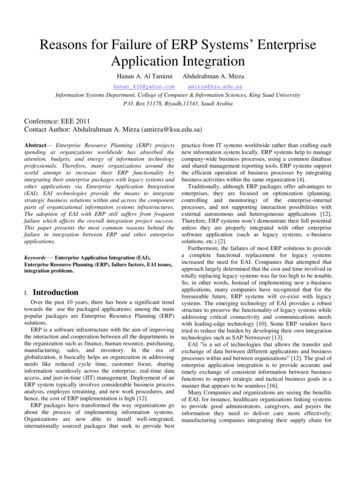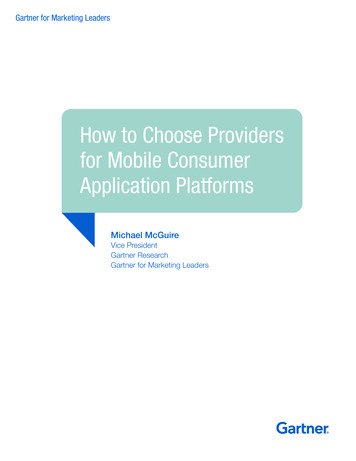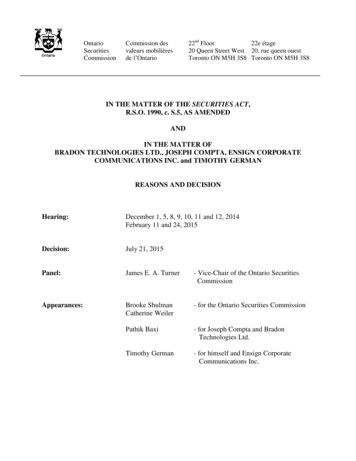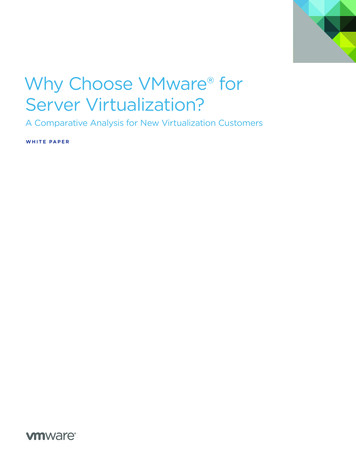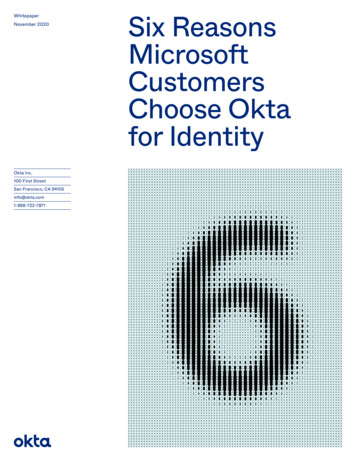
Transcription
WhitepaperNovember 2020Okta Inc.100 First StreetSan Francisco, CA 94105info@okta.com1-888-722-7871Six ReasonsMicrosoftCustomersChoose Oktafor Identity
WhitepaperContentsSix Reasons Microsoft Customers Choose Okta for Identity2Introduction3Simplified Single Sign-Onfrom Active Directory4Automated User Lifecycle Management5Faster Office 365 Deployments6Adaptive Security7Smoother Mergers and Acquisitions8Works Great with Microsoft and Other Technologies1
WhitepaperIntroductionSix Reasons Microsoft Customers Choose Okta for Identity2If your organization uses Microsoft, it’s time to take a closer look at identity management.The right identity solution can speed adoption of cloud technologies, and help modernizelegacy systems and applications for the cloud. Many Microsoft customers end upchoosing Okta to manage identity for their cloud applications.Here are six reasons why.
Whitepaper1. SimplifiedSingle Sign-Onfrom ActiveDirectorySix Reasons Microsoft Customers Choose Okta for Identity3Organizations with investments in a directory service such as Active Directory wantto use it to enable Single Sign-On (SSO) to both on-premises and cloud applications.When architected properly, Single Sign-On eliminates the frustration of having tocreate and remember unique passwords for each application, and it improves thesecurity of corporate data.Microsoft provides a set of tools to enable SSO via their Azure AD cloud service:Active Directory Federation Services (AD FS), Azure AD Connect (previously known asDirSync), Password Sync, Passthrough authentication, and Microsoft Identity Manager(previously Forefront Identity Manager). These tools have gradually improved over time,but require deploying, configuring, and managing significant server resources. Eachservice requires individual configuration and integration with the Azure AD cloud service.Customers turn to Okta when they realize they can deploy SSO from Active Directoryin much less time. Okta is a vendor-neutral cloud based identity and access solutionthat requires no tradeoffs between ease of use and full functionality.Simplified Single Sign-On
Whitepaper2. AutomatedUser LifecycleManagementSix Reasons Microsoft Customers Choose Okta for Identity4There will always be a flux of users that join and leave your organization. When IT saysthey can no longer manage user onboarding and offboarding using a checklist, it’s timefor lifecycle management. As users join, they require day one access to the applicationsthey need. When they leave, IT must remove their access to everything, immediately.Okta makes it easy to create new user accounts for cloud apps, and deploy the appswith the correct access level. Okta syncs in real-time to Active Directory, LDAP, orother directories. As people change job roles or leave, Okta automatically changes orremoves their access to applications and services based on these identity changes.Many companies today are using cloud-based human capital management (HCM)systems like Workday to simplify the way their Human Resources department getswork done. Even with a powerful HCM tool, the onboarding process for new hires canbe painful, often requiring IT to respond to tickets manually, and create accounts inapps and systems for each new user.With Okta’s Workday Integration, the HR department can drive the entire employeelifecycle from onboarding to job changes to offboarding, and provide access to theapps and directories users need.Microsoft currently supports integration with Workday, while other HCM systemsrequire custom integration using Microsoft Identity Manager and SQL servers. Oktasupports HR-driven onboarding and offboarding from Workday and all other popularHCM systems including UltiPro, BambooHR, SuccessFactors, G Suite and Netsuite.Automated used lifecycle management
WhitepaperSix Reasons Microsoft Customers Choose Okta for Identity3. FasterOffice 365DeploymentsOffice 365 is by far the most complex cloud application suite you may ever have tomanage, and many Microsoft-centric organizations choose Okta specifically forOffice 365. That’s because Okta shortens Office 365 deployment time, supports bothweb and native Office 365 apps, and offers unique automation and user experienceimprovements that save on long-term operational costs.5Many medium- to large-sized organizations using Office 365 require high availability,automated onboarding and offboarding, and license management. For better security,they need federated Single Sign-On instead of synced passwords. They may also needto support third-party mobile device management, network security, and integrationwith a cloud application security broker. To achieve all this, Microsoft recommendsdeploying Office 365 with AD FS, Azure AD Connect, and Microsoft Identity Manager(MIM)—a process that can take about 18-24 months. Okta supports all of theserequirements out-of-box, and gets it all done six times faster.Simplify and accelerate Office 365 deployments—all from a single platformHow are you managing Office 365 licenses? Can you provision licenses automaticallybased on user roles and group membership? Ideally you should be able to specify whichOffice 365 services get enabled during user onboarding. For example, you could assignMicrosoft E3 licenses with only Exchange and Lync enabled for your Sales team, whileyour Support team gets an E3 license with SharePoint Online enabled. Okta takes careof license management. IT just needs to create a user in Active Directory and assignthem to a group, and Okta will automate everything else. The new employee caneasily gain access to Office 365 within a matter of seconds of IT initiating the process.Enhanced offboarding capabilities will allow IT to remove licenses for deactivated users.
Whitepaper4. AdaptiveSecuritySix Reasons Microsoft Customers Choose Okta for Identity6Microsoft-centric organizations have the same concerns as any organization adoptingcloud technologies. 73% of passwords are duplicates1, so it’s no wonder that 81% ofdata breaches involve stolen or weak credentials2, and 91% of phishing attacks targetuser credentials3. Multi-Factor Authentication (MFA) is a way to reduce the risk ofstolen passwords by requiring a second, or even a third way to verify a user’s identitybefore they are allowed access to any applications and systems.Security needs to adapt to changing circumstances and unusual events, so identitiesand assets are still secured without overburdening users. Okta’s adaptive MFA allowsfor dynamic policy changes and step-up authentication that responds to changes inuser and device behavior, location, or other contexts. Okta’s MFA is built for rapidexpansion into the cloud, and supports on-premises authentication for VPN, RDP, andSSH. Hybrid environments and mobile users are also covered, so access to apps anddata is always secured.While Microsoft offers a cloud-based solution for MFA, you would need to deploy theiron-premises MFA server along with AD FS to get the same level of features that Oktaprovides out-of-box. Okta’s adaptive MFA provides strong authentication across allapplications, and supports more third-party MFA factors like U2F, YubiKey, SmartCards, Google Authenticator and more. Okta requires no on-premises MFA servers,and is easy to use for both administrators and end users.Adaptive security[1] Source: TeleSign 2016 Consumer Account Security Report[2] Source: 2017 Verizon Data Breach Investigations Report[3] Source: 2016 Verizon Data Breach Investigations Report
Whitepaper5. SmootherMergers andAcquisitionsSix Reasons Microsoft Customers Choose Okta for Identity7Organizations undergoing mergers & acquisitions need to consolidate multiple userdomains to provide access to business-critical applications.After a merger, there are multiple directories or domains for different user populations.Consolidating these domains is costly, takes a long time and has security implications.IT becomes a bottleneck and end users spend weeks to months waiting for accessto parent company resources. Multiple, inconsistent security policies can create asecurity risk for the business. Meanwhile IT has limited visibility into who has accessto what resources.Identity management is the key control point to integrate users in different organizationsto shared applications. Okta helps organizations connect different populations andgeographies without the need to set up Active Directory Trusts, modify firewall policies,or invest in more infrastructure to connect them all together. Okta integrates identitiesfrom any number of Active Directory domains and reduces the directory cleanup andreconciliation process. Users in newly acquired organizations get day one access toparent company resources, while IT gets a single pane view of security for the entireorganization.Centralize identities across any number of directories or domains
Whitepaper6. Works Greatwith Microsoftand OtherTechnologiesSix Reasons Microsoft Customers Choose Okta for Identity8Microsoft customers also choose Okta for identity because of its strong partnershipand broad integration with Microsoft products including Office 365, Windows 10,Azure Active Directory, SharePoint, and Intune. Okta’s cloud-based identity solutionworks great with Microsoft and other technology vendors. Our vendor-neutral identityarchitecture makes it easy to roll out Microsoft products and thousands of other cloudapplications and services.Broad integration for Microsoft productsFor more information, visit https://www.okta.com/microsoft-integrations/or contact us at https://www.okta.com/contact-sales/ to talk to a salesrepresentative.About OktaOkta is the leading independent provider of identity for the enterprise. The OktaIdentity Cloud enables organizations to securely connect the right people to theright technologies at the right time. With over 6,500 application integrations,Okta customers can easily and securely use the best technologies for their business.To learn more, visit okta.com.
DirSync), Password Sync, Passthrough authentication, and Microsoft Identity Manager (previously Forefront Identity Manager). These tools have gradually improved over time, but require deploying, configuring, and managing significant server resources. Each service requires individual confi



